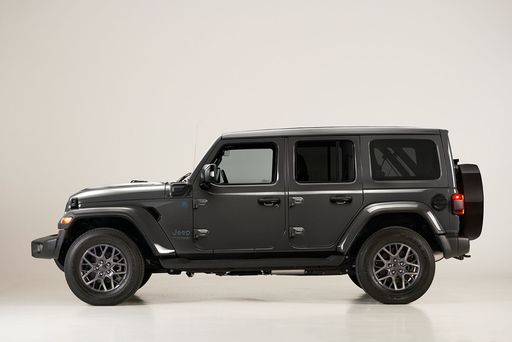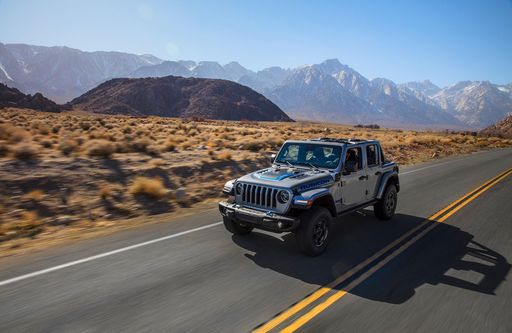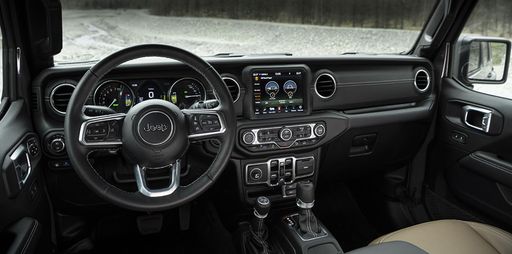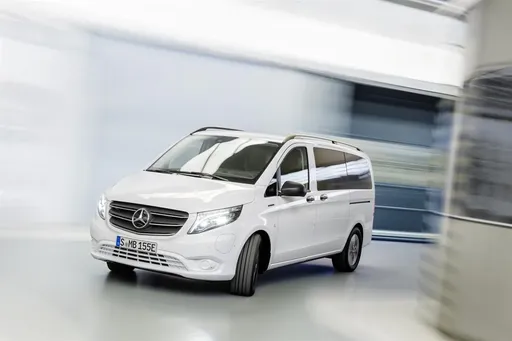Jeep Wrangler VS Mercedes Vito Bus – Specs, Efficiency & Price Comparison
Which model is the better choice – the Jeep Wrangler or the Mercedes Vito Bus? We compare performance (380 HP vs 237 HP), boot capacity (533 L vs 1390 L), efficiency (3.30 L vs 26.70 kWh6.70 L), and of course, the price (69900 £ vs 36300 £).
Find out now which car fits your needs better!
The Jeep Wrangler (Off-Roader) is powered by a Plugin Hybrid engine and comes with a Automatic transmission. In comparison, the Mercedes Vito Bus (Bus) features a Diesel, Electric or Petrol engine and a Manuel or Automatic gearbox.
When it comes to boot capacity, the Jeep Wrangler offers 533 L, while the Mercedes Vito Bus provides 1390 L – depending on what matters most to you. If you’re looking for more power, you’ll need to decide whether the 380 HP of the Jeep Wrangler or the 237 HP of the Mercedes Vito Bus suits your needs better.
There are also differences in efficiency: 3.30 L vs 26.70 kWh6.70 L. In terms of price, the Jeep Wrangler starts at 69900 £, while the Mercedes Vito Bus is available from 36300 £.
Compare all the key specs now and find out which model fits your lifestyle best!
Jeep Wrangler
The Jeep Wrangler is a symbol of rugged adventure and off-road capability, renowned for its distinctive boxy design and iconic seven-slot grille. Its interior blends practicality with modern technology, providing a comfortable environment whether you're navigating city streets or challenging terrains. With a loyal fan base, the Wrangler continues to capture the spirit of freedom and exploration, making it a favourite among outdoor enthusiasts.
details @ media.stellantis.com
@ media.stellantis.com
 @ media.stellantis.com
@ media.stellantis.com
 @ media.stellantis.com
@ media.stellantis.com
 @ media.stellantis.com
@ media.stellantis.com
 @ media.stellantis.com
@ media.stellantis.com
Mercedes Vito Bus
The Mercedes-Benz Vito Bus offers a versatile solution for those in need of spacious and comfortable group transportation. Its refined interior is designed to enhance passenger comfort, making it ideal for both business and leisure travel. With a focus on safety and efficiency, it provides a reliable driving experience that aligns with the high standards expected of the Mercedes-Benz brand.
details

|

|
|
|
|
Costs and Consumption |
|
|---|---|
|
Price
69900 - 71600 £
|
Price
36300 - 59000 £
|
|
Consumption L/100km
3.3 - 4 L
|
Consumption L/100km
6.7 - 10 L
|
|
Consumption kWh/100km
-
|
Consumption kWh/100km
26.7 - 26.9 kWh
|
|
Electric Range
38 - 42 km
|
Electric Range
248 - 370 km
|
|
Battery Capacity
-
|
Battery Capacity
60 - 90 kWh
|
|
co2
74 - 91 g/km
|
co2
0 - 228 g/km
|
|
Fuel tank capacity
65 L
|
Fuel tank capacity
57 - 70 L
|
Dimensions and Body |
|
|---|---|
|
Body Type
Off-Roader
|
Body Type
Bus
|
|
Seats
5
|
Seats
8
|
|
Doors
5
|
Doors
4
|
|
Curb weight
2276 - 2383 kg
|
Curb weight
2023 - 2739 kg
|
|
Trunk capacity
533 L
|
Trunk capacity
580 - 1390 L
|
|
Length
4882 mm
|
Length
4895 - 5370 mm
|
|
Width
1894 mm
|
Width
1928 mm
|
|
Height
1838 - 1848 mm
|
Height
1890 mm
|
|
Payload
520 - 536 kg
|
Payload
726 - 1077 kg
|
Engine and Performance |
|
|---|---|
|
Engine Type
Plugin Hybrid
|
Engine Type
Diesel, Electric, Petrol
|
|
Transmission
Automatic
|
Transmission
Manuel, Automatic
|
|
Transmission Detail
Automatikgetriebe
|
Transmission Detail
Schaltgetriebe, Automatikgetriebe
|
|
Drive Type
All-Wheel Drive
|
Drive Type
Rear-Wheel Drive, All-Wheel Drive, Front-Wheel Drive
|
|
Power HP
380 HP
|
Power HP
136 - 237 HP
|
|
Acceleration 0-100km/h
6.50 s
|
Acceleration 0-100km/h
-
|
|
Max Speed
156 - 177 km/h
|
Max Speed
140 km/h
|
|
Torque
637 Nm
|
Torque
330 - 500 Nm
|
|
Number of Cylinders
4
|
Number of Cylinders
4
|
|
Power kW
280 kW
|
Power kW
100 - 174 kW
|
|
Engine capacity
1995 cm3
|
Engine capacity
1950 - 1999 cm3
|
General |
|
|---|---|
|
Model Year
2024
|
Model Year
2024
|
|
CO2 Efficiency Class
B
|
CO2 Efficiency Class
G, A
|
|
Brand
Jeep
|
Brand
Mercedes-Benz
|
Jeep Wrangler
Introduction to the Iconic Jeep Wrangler
The Jeep Wrangler has long been synonymous with off-road capability and rugged design. With its roots deeply embedded in adventure and exploration, the Wrangler combines classic styling with modern innovations. In its latest iterations, it continues to enhance its reputation as a robust, yet stylish, off-roader suitable for a variety of terrains and conditions.
Technical Specifications and Performance
The 2023 Jeep Wrangler models offer a range of options, with engines that are designed to deliver powerful performance and efficiency. The available engine configurations include advanced Plug-in Hybrid options, as well as traditional petrol engines. All options are paired with an automatic transmission and benefit from the capability of an all-wheel-drive system.
Power output varies from 272 to 380 PS, catering to different driving preferences and demands. The Plug-in Hybrid variant impresses with a consumption as low as 3.3 L/100km, offering an electric range of up to 48 km—ideal for urban commutes and reducing environmental impact. For those wanting a more traditional power experience, the petrol engines deliver robust performance with an acceleration of 0-100 km/h in just 6.5 to 7.6 seconds, depending on the variant.
Innovative Features and Sustainability
The Jeep Wrangler is not just about raw power; it also embodies sustainability with its hybrid technologies. The Plug-in Hybrid models are designed to offer a blend of efficiency and environmentally friendly driving experience. By integrating electric motor capabilities with traditional fuel engines, these models ensure lower emissions and enhanced fuel economy.
Beyond mechanical advancements, the modern Wrangler incorporates cutting-edge technology in its interior. With a suite of safety features and a sophisticated infotainment system, it ensures both driver and passengers enjoy a comfortable and secure journey.
Exterior Design and Interior Comfort
The exterior of the Jeep Wrangler remains a testament to its enduring legacy, featuring the iconic seven-slot grille and round headlights. Yet, it manages to blend this classic look with modern aesthetics, providing a more refined appearance that does not compromise its rugged appeal.
Inside, the Wrangler offers a spacious interior with seating for five, ensuring comfort during long drives. Thoughtfully designed with high-quality materials, the cabin provides both functionality and style. With a generous boot space of 533 litres, it caters to both city drivers and adventure seekers alike.
Versatility and All-Terrain Capability
True to its heritage, the Jeep Wrangler excels in off-road conditions. Thanks to its high ground clearance, robust suspension system, and advanced all-terrain technology, it is perfectly equipped to handle challenging terrains with ease. Whether it's muddy trails or rocky paths, the Wrangler stands ready to tackle any obstacle.
Conclusion: A Vehicle for All Adventures
The 2023 Jeep Wrangler continues to embody the spirit of adventure that has defined the brand for decades. With a combination of powerful performance, advanced hybrid technology, and timeless design, it remains a top choice for those who seek a vehicle as versatile and robust as their lifestyle. Whether navigating urban streets or exploring off-beaten paths, the Wrangler proves once again why it is an enduring favourite among off-road enthusiasts.
Mercedes Vito Bus
The Mercedes Vito Bus: A Comprehensive Look at Innovation and Performance
In the automotive world, the Mercedes Vito Bus stands out as a versatile and reliable choice for those in need of a spacious and efficient mode of transport. With a reputation for engineering excellence, Mercedes-Benz has once again delivered with the latest versions of the Vito Bus. This article delves into the technical aspects, innovations, and what makes the Vito Bus a prime option in its segment.
Engine Power and Efficiency
The Mercedes Vito Bus offers a remarkable range of engine configurations, catering to both diesel and electric powertrains. The diesel models come with options ranging from 136 HP to a powerful 237 HP. The robust four-cylinder diesel engines are designed for efficiency, offering a range of fuel consumption figures from 6.7 L to 7.8 L per 100 kilometers, depending on the variant. Meanwhile, the electric eVito Tourer provides an impressive alternative with a power output of 204 HP and offers ranges of up to 371 kilometers on a single charge, making it a frontrunner in sustainable transportation solutions.
Transmission and Drivetrain Options
The Vito Bus is equipped with both manual and automatic transmission options, ensuring a drive tailored to user preferences. The 9G-TRONIC automatic gearbox is notable for its smooth transitions, enhancing the driving experience. Customers can choose between rear-wheel drive and the adaptable all-wheel drive system. The introduction of the eVito Tourer's front-wheel drive system further expands the versatility of the lineup, offering an electric alternative for urban and rural environments alike.
Interior Comfort and Practicality
The interior of the Vito Bus is designed with comfort and convenience in mind. Capable of seating up to eight passengers, the spacious cabin is ideal for family travel or business transportation. The Vito Bus offers three body lengths—kompakt, lang, and extralang—providing flexibility to accommodate different passenger and cargo requirements. The well-thought-out design ensures ample storage with trunk capacities ranging up to 1,390 liters in certain configurations.
Advanced Innovations
Mercedes-Benz has equipped the Vito Bus with a host of advanced technological features. The focus on safety is evident, with systems like Crosswind Assist and Attention Assist, ensuring greater control and alertness on the road. The eVito Tourer comes with the latest in electric vehicle technology, including efficient battery management systems that optimize range and performance.
Performance and Dynamics
The Vito Bus showcases impressive performance metrics across its variants. With a maximum torque ranging from 330 Nm to 500 Nm, the Vito Bus ensures a responsive and agile driving experience. The consistent build quality and dynamic chassis contribute to a pleasing ride, whether navigating city streets or cruising on the highway.
Conclusion
The Mercedes Vito Bus continues to be a leading choice for those looking for a reliable and performance-oriented vehicle. With its diverse range of engine options, innovative features, and versatile configurations, the Vito Bus meets the demands of both personal and professional transportation. The introduction of electric variants highlights Mercedes-Benz's commitment to sustainability without compromising on power or range. As the automotive industry continues to evolve, the Vito Bus exemplifies the blend of traditional excellence and forward-thinking innovation.
The prices and data displayed are estimates based on German list prices and may vary by country. This information is not legally binding.
